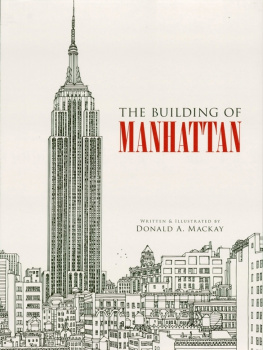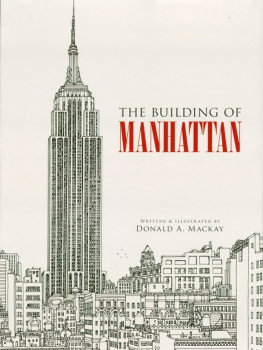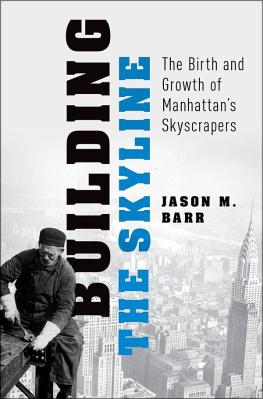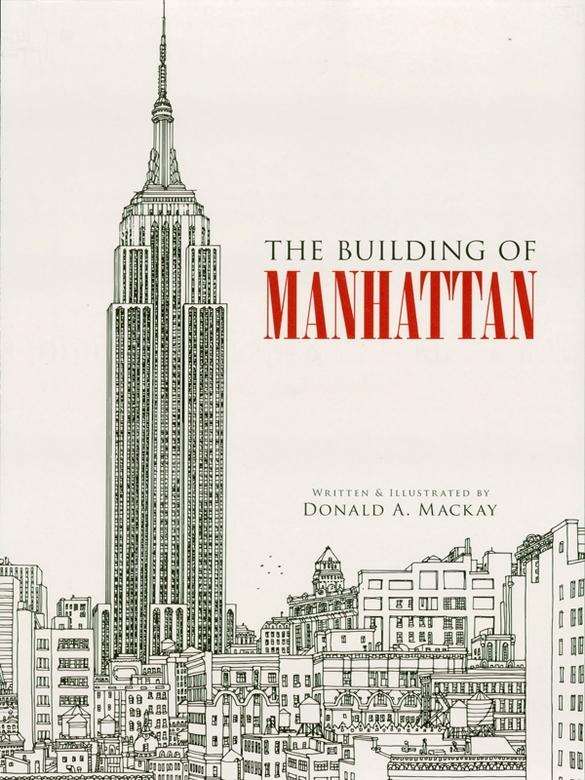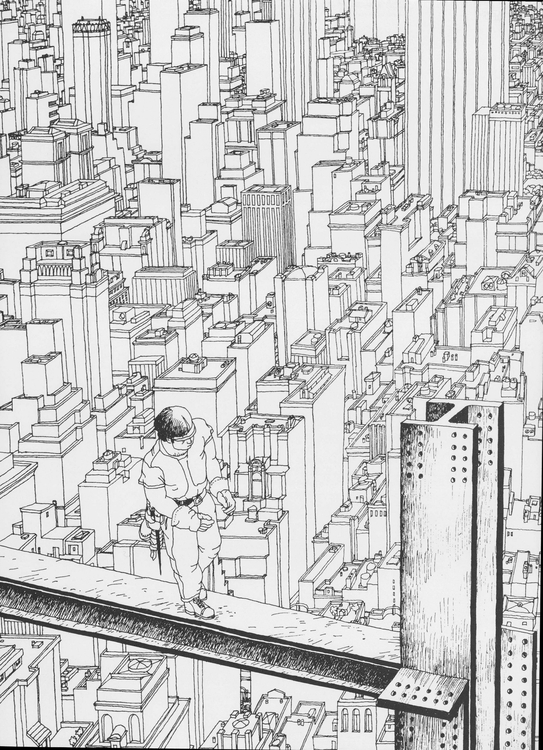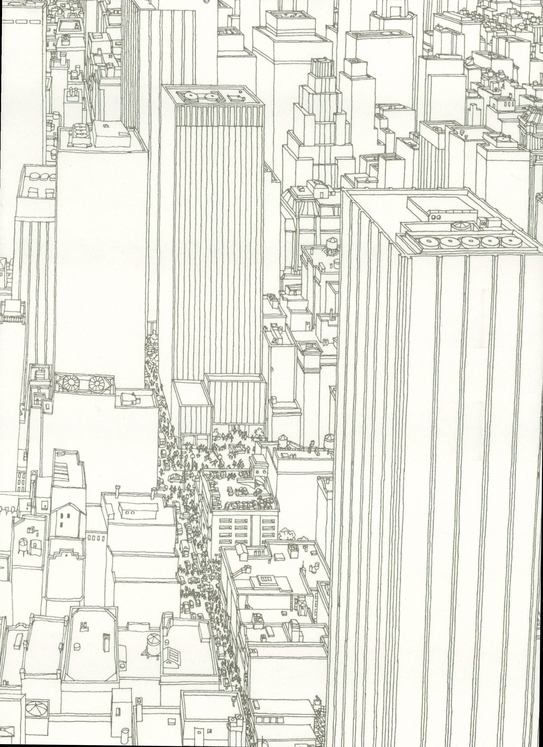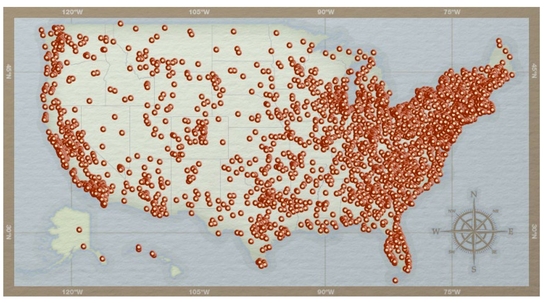ACKNOWLEDGMENTS
Invariably the people involved in the planning and construction of the buildings, and those working for the city and for the utilities, have been helpful. I regret not having asked more individuals for their names; some preferred to remain anonymous. If by chance someone reads this and recalls his or her own contribution, my thanks to you. Most especially to Elmer Richards and George Tamaro of Mueser Rutledge Consulting Engineers, who offered their time, knowledge and help and to my son Neil, with his invaluable word processor and assistance.
To John Hughes and Mary Layton of the Port Authority of New York and New Jersey, Alan Ritchie of John Burgee Architects with Philip Johnson, Frederick B. Davidson of the Battery Park City Authority, John Leeper, Sol Olsher and Frank Rohauer of HRH Construction Corp., Chuck Appel and Martin Gitten of Con Edison, William Heard of Otis Elevator, Bevin Maguire of Rockefeller Center Management Corp., Felix Sanchez and Paul Leontzwick of NYNEX, Edward Stegeman of Empire City Subway, William Rosado and his associates, Ronnie Pollicino and his crew. To John Hunt and Harold Manchester especially, and to Ed Schussler and all those who put up 527 Madison Avenue.
To Fred Liebmann, Ralph Lamo, Fred Sturges, Bruce Kahan, Wallace Rosenwach, Dana Gunter, Jim Duggan, Robert McGiveron, Tim OBrien, Don Casamassina, Philippe Petit, George Willig, Owen Quinn, William Reidy, John Brennan, Lillian Alaya, Dr. Sherene Baugher, Dr. Nick Isyumov, and many others, thanks.
To the City of New York and its Department of Environmental Protection for its many books and pamphlets, and to the citys own bookstore, Citybooks, where in addition to codes and regulations, one can buy a sixty-five pound cast-iron Seal of the City that once was part of the West Side Highway.
I made extensive use of both the Central Research Library and the Mid-Manhattan Branch of the New York Public Library. The portion of the Ratzer Map of 1767 and the portion of the Viele Map of 1874 are both from the Map Division; the 1797 watercolor by George Holland of Broad Street is from the I. N. Phelps Stokes Collection; the line engraving of the cast-iron store front from Badgers Catalog is from the Art, Print and Photographs Division; and the line engraving showing cast-iron construction, 1858, is from the General Research Division. All of these are from the Astor, Lenox and Tilden Foundations of the New York Public Library, with help from Anna Bartrnon. The librarys technical and historical books, and the microfilm records of the New York Times and of technical journals were invaluable.
The Museum of the City of New York has been very helpful, especially for its displays of the early Dutch settlers on Manhattan Island. The Teunis Tomasen mentioned in the text. also known as Teunis Tomasen Quick, is an early ancestor. Thanks to Terry Ariano for her help with the Museums Print Collection. Also to Martha de Montao of the Museum of the American Indian, and to Katherine Naylor of the New York Historical Society. The drawings of the men working on the Empire State Building are imagined, based on photographs taken by Louis Hine, courtesy of George Eastman House and Coralee Aber.
SOURCES
| PAGE |
| 6-7 | Mantles of Feathers... of good Furres. J. Franklin Jameson, editor, Narratives of New Netherland, 16091664. (New York: Charles Scribners Sons, 1909), p. 19. |
| This is a very good Land... Land to see. Ibid., p. 17. |
| of the bark of trees. 1. N. Phelps Stokes, The Iconography of Manhattan Island, vol. 1, p. 10. |
| delivered to him at thirteen inches to the foot. Ibid., vol. 2, p. 247. |
| at his own pleasure... cannot be prejudiced thereby. Berthold Fernow, editor, The Records of New Amsterdam from 1653 to 1674. (New York: The City of New York, 1897), p. 207. |
| Isaac de Forest registers at the office... guiders for the job. Stokes, Iconography, vol. 4, p. 94. |
| with provisions and drink until the work is completed. Ibid., vol. 4, p. 115. |
| 1011 | Scituate upon the Island commonly knowne by the Name of Manhatoes. Ibid., vol. 4, p. 240. |
| 1213 | at which all negro and Indian slaves... took their stand. David T. Valentine, Manual of the Corporation of the City of New York, vol. 1849, p. 353. |
| 1415 | in the morning the American troops marched ... and took possession of the city. Ibid., vol. 1870, p. 826. |
| 1617 | by which it was provided that no master.... to make satisfaction in some other way. Thomas E. V. Smith, The City of New York in the Year of Washingtons Inauguration 1789 ( 1889; reprint ed., Riverside, Conn.: Chatham Press in cooperation with the U.S. Dept. of the Interior, National Park Service, Federal Hall National Memorial, New York City, 1972), p. 100. |
| every negro, mulatto, or mestee who was a slave.... punishable by 40 shillings fine. Ibid., p. 122. |
| 1819 | a four storey brick house.... twenty-eight feet four inches wide. Ibid., p. 27. |
| 2021 | To some it may be a matter of surprise.... Harlem Flat will be covered with houses. Valentine, Manual of Corporation of the City of New York, vol. 1866, p. 759. |
| the Mayor draw on the city Treasurer... as a compliment to the workmen. Ibid., vol. 1853, p. 469. |
| 2223 | The city is now undergoing its usual annual metamorphosis... to its utmost extent. Philip Hone, The Diary of Philip Hone, |
| 18281851 (New York: Dodd, Mead & Company, 1889, 1927, 1936), p. 41. |
| The spirit of pulling down.... once in ten years. Ibid., 395. |
| 2425 | The cast-iron frame of the building.... which may be ornamented to any taste. James Bogardus, Cast-Iron Buildings, Their Construction and Advantages, pamphlet (New York, 1858). |
| 2627 | energy of 8,500 incandescent lamps. Harpers Weekly, January 18, 1890. |
| 3233 | A type of construction ... carries all stresses directly to the foundations. The Architectural Record, August 1934, p. 114. |
| An iron bridge truss stood on end was the solution of the problem. New York Times, May 21, 1905, p. 6. |
| the earliest example of skeleton construction... date 1888-9. Ibid. |
| 3637 | unfortunately for the science of construction... skeletons cased with masonry. The American Architect and Building News, vol. 77, no. 1396, 1902. |
| For many reasons this building is unique.... twentieth: 10 feet 6 inches. American Local History. booklet, the New York Public Library, p. 91. |
Find more books like this at
www.imagesofamerica.com
Search for your hometown history, your old
stomping grounds, and even your favorite sports team.
IN THE BEGINNING
M anhattan Island is of very recent ori of very recent gin, in geological time.

